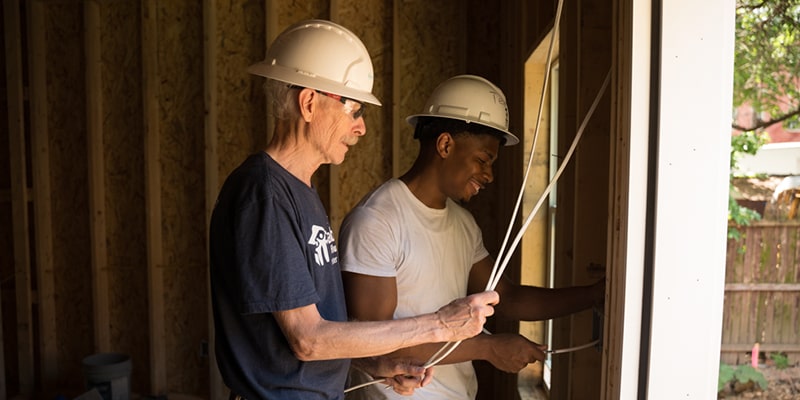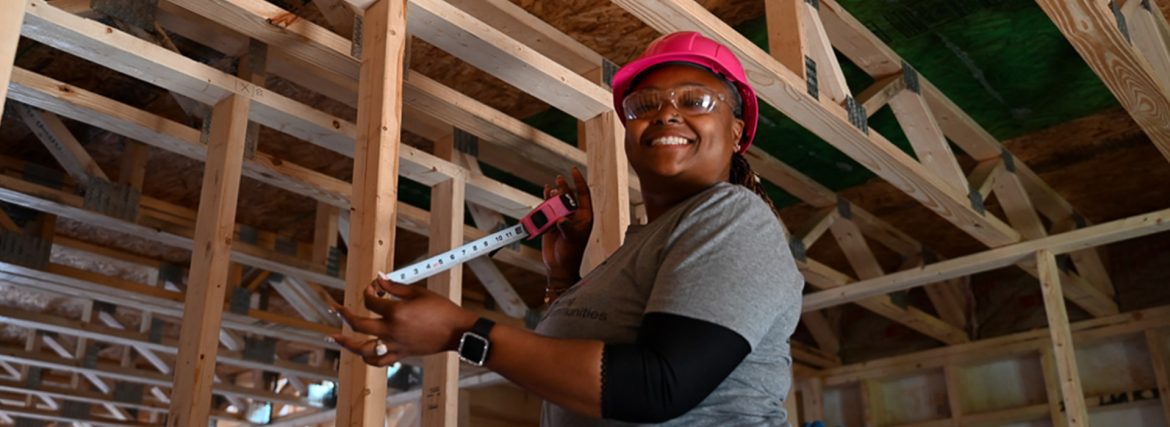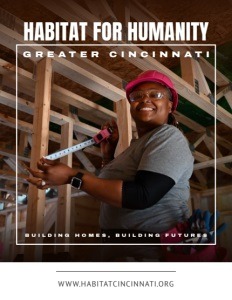Building Homes, Building Futures
Expanding the Housing Focus Through Construction Training and Community Development
In Cincinnati, the dream of homeownership is becoming increasingly out of reach for many working families. One thing remains consistent however, the need for affordable housing continues and has arguably never been more urgent.
For Habitat for Humanity of Greater Cincinnati, that urgency fuels action. The organization, long known for building homes alongside partner families, is scaling its impact — constructing more houses, repairing more existing homes, and training the next generation of skilled workers who will carry its mission forward.
“We operate four main lines of business,” says Joe Hansbauer, President and CEO. “We build new homes for first-time buyers below 80% of area median income, run a critical home repair program, operate six ReStores, and manage our construction training program. All of it connects back to creating safe, affordable homeownership opportunities.”
A Growing Mission
Over the last several years, Habitat Cincinnati has expanded far beyond its traditional roots. Once producing about 15–17 homes annually, the organization built 23 new homes last year and expects to maintain production in the mid-20s before nearly doubling output to 40–50 homes per year through new land development initiatives.
The nonprofit is also completing around 200 critical home repairs each year for existing homeowners — work that enables low-income families to stay in their homes safely and affordably.
At the same time, Habitat is taking on a new challenge: acting as a land developer, designing small subdivisions and multi-income neighborhoods that integrate affordable housing with market-rate homes.
“We’re growing into a wider land development operation,” Hansbauer explains. “That shift will allow us to scale our production and think about community-level impact — not just individual homes.”
Cincinnati’s Housing Crisis
That growth comes at a critical moment. Like many American cities, Cincinnati faces an acute housing shortage driven by decades of under-building and population growth.
“Our problem isn’t skyrocketing demand so much as insufficient supply,” Hansbauer says. “We need more units of all kinds — market-rate and affordable — but the ‘starter home’ just doesn’t exist in the private market anymore.”
Homes under 1,400 square feet with modest prices, once the entry point for first-time buyers, have largely disappeared. Developers, constrained by labor shortages and high material costs, focus on projects with higher margins. The result is a market where even middle-income families struggle to buy, and where renters are increasingly priced out.

“It’s harder than ever for families to get into homeownership,” Hansbauer adds. “That’s where Habitat comes in — bridging the gap for those who can sustain a mortgage but can’t break into the market.”
Training Tomorrow’s Builders
Addressing the housing shortage also means addressing another pressing problem: the shortfall of skilled construction workers. Across the U.S., builders face acute labor shortages, with more retirements than new entrants joining the trades.
To help close that gap, Habitat for Humanity of Greater Cincinnati operates an innovative six-week construction training program designed to introduce adults with little or no prior experience to the building trades.
Hosted at the CityLink Center — a local hub for workforce and social-service support — the program offers five cohorts per year, each serving 5–12 participants.
“It’s basic, entry-level training focused on individuals who are new to construction,” Hansbauer explains. “Participants receive OSHA-10 certification, learn site safety, tool identification, and foundational trade skills. Then they spend about five full days on Habitat build sites applying what they’ve learned.”
Graduates can transition directly into full-time employment or continue into a second six-week internship that provides hands-on site experience, income, and career coaching — from résumé building to interview preparation.
“Our goal is job placement,” Hansbauer says. “When participants get hired full-time, that’s success.”
Workforce Development in Action
While some graduates are hired as assistant site supervisors within Habitat’s own projects, most move on to roles with local subcontractors and construction firms. That dual purpose — expanding affordable housing while strengthening the regional labor pool — has made the program a cornerstone of Habitat’s workforce development efforts.
“As we scale, our subcontractor partners need more skilled labor,” Hansbauer explains.
“This program helps fill that pipeline. We’re meeting a community need and an industry need at the same time.”
The initiative also complements the resurgence of career and technical education (CTE) in local high schools and trade programs. Habitat collaborates with regional education partners to give students hands-on experience on build sites, linking classroom learning with real-world application.
“We want young people to see the trades as viable, respected career paths,” Hansbauer says. “These are well-paying, entrepreneurial jobs with huge opportunities.”

Safety and Site Readiness
Hansbauer highlights that workplace safety is built into every aspect of the training.
“A big portion of the classroom curriculum is OSHA certification and understanding job-site culture,” Hansbauer notes. “We teach participants what to expect, how to stay safe, and how to operate professionally in a live construction environment.”
Habitat’s work sites double as training grounds — diverse, supportive spaces where participants learn by doing under professional supervision. “It’s a great bridge between learning and employment,” he adds. “By the time they’re hired full-time, they’ve already operated in a real worksite environment.”
Design and Development Innovation
While the organization is best known for its classic single-family homes, Habitat Cincinnati has diversified its architectural approach to meet modern needs and urban constraints.
The team now works with six core home models, each between 900 and 1,400 square feet, designed in-house for efficiency, sustainability, and adaptability. Materials and rooflines vary to blend seamlessly into surrounding neighborhoods.
Recently, the organization introduced a connected rowhouse model — zero-lot-line homes offering full ownership, not condominium units.
“This product helps us build in denser urban areas where land is limited,” Hansbauer says. “It allows us to serve more families while respecting neighborhood character.”
Partnerships and Economic Impact
Habitat for Humanity of Greater Cincinnati operates across nine counties and three states, coordinating with more than 150 municipalities. The organization’s reach makes partnership essential.
Working with the City of Cincinnati, Hamilton County, and the Port Authority’s land bank, Habitat redevelops underused land and transforms vacant lots into vibrant communities. Funding and capital support often come through Opportunity Zones, New Markets Tax Credits, Federal Home Loan Bank programs, and Welcome Home Ohio grants.
“Each project has its own mix of partnerships and funding,” Hansbauer explains. “We work closely with civic and economic development organizations to align our projects with regional priorities.”
That collaboration extends to the Home Builders Association, local subcontractors, and chambers of commerce — ensuring a strong, connected supply chain for both materials and labor.
“We’re one of the top 15 homebuilders in our region by volume,” Hansbauer notes. “We operate like a business — paying subcontractors, maintaining schedules, and delivering quality homes — but with a nonprofit mission at the heart of it.”
Looking Ahead: Scaling for Impact
Habitat for Humanity of Greater Cincinnati is firmly in growth mode. Over the next two years, the organization aims to bring four to six land-development projects online simultaneously, each designed to deliver dozens of new homes annually.
“We’re moving from building 20 homes a year to 50,” Hansbauer says. “It’s still a fraction of the need in our community, but every step helps close that gap.”
As the Cincinnati housing market continues to tighten, Habitat’s integrated approach — combining affordable housing, workforce development, and land innovation — is proving to be both timely and transformative.
“The Habitat mission extends beyond building homes, to include building communities and hope” says Hansbauer. “This mission will always remain at the center of our identity, even as we scale to change more lives and communities.”
AT A GLANCE
Who: Habitat for Humanity Greater Cincinnati
What: Well recognized organization focused on creating housing that is affordable and creating jobs that are sustainable
Where: Cincinnati, Ohio
Website: www.habitatcincinnati.org


